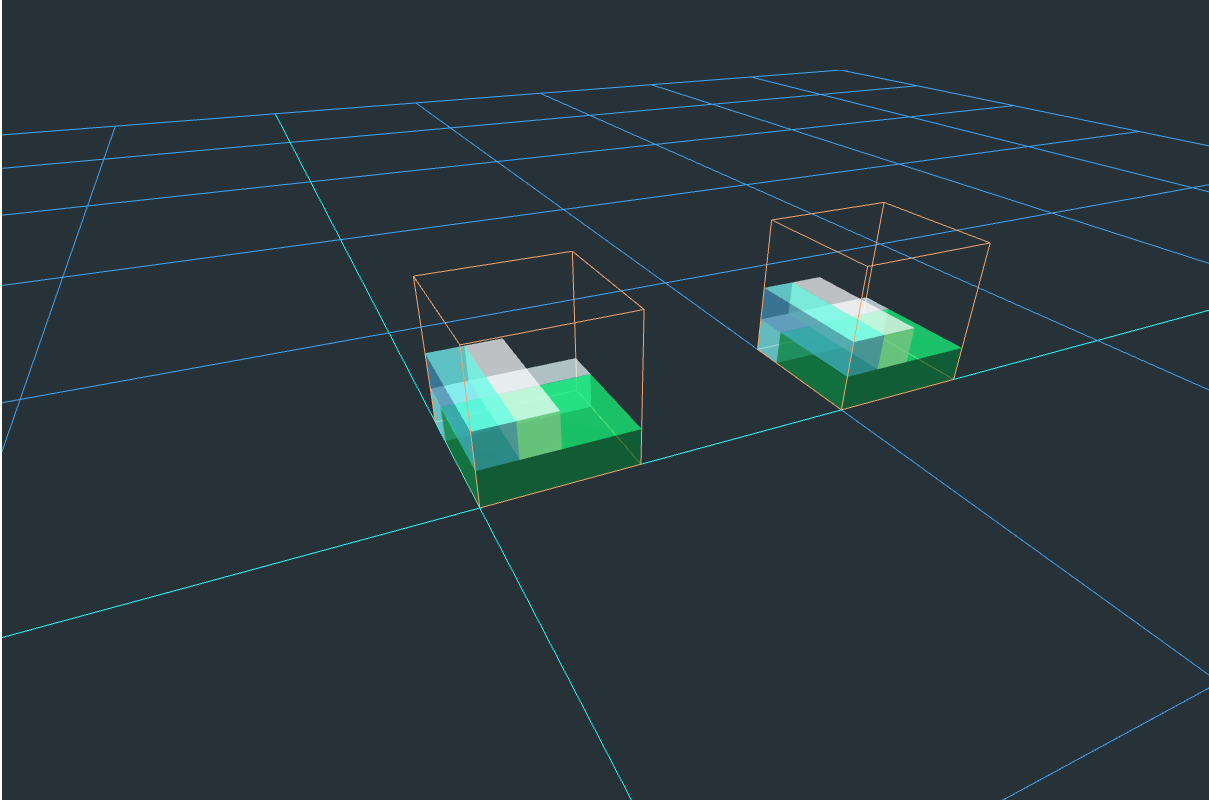This library does 3D rectangular bin packing; it attempts to match a set of 3D items to one or more in a set of 3D containers. The result can be constrained to a maximum number of containers.
Projects using this library will benefit from:
- short and predictable calculation time,
- fairly good use of container space,
- brute-force support for low number of boxes
So while the algorithm will not produce the theoretically optimal result (which has an O(n2) complexity), its reasonable simplicity means that in many cases it would be possible to stack the resulting container for a human without instructions.
In short, the library provides a service which is usually good enough, in time and reasonably user-friendly ;-)
Bugs, feature suggestions and help requests can be filed with the issue-tracker.
The project is implemented in Java and built using Maven. The project is available on the central Maven repository.
Example dependency config:
<dependency>
<groupId>com.github.skjolber.3d-bin-container-packing</groupId>
<artifactId>core</artifactId>
<version>2.0.4</version>
</dependency>Java 11+ projects please use module com.github.skjolber.packing.core.
The units of measure is out-of-scope, be they cm, mm or inches.
Obtain a Packager instance:
Container container = Container.newBuilder()
.withDescription("1")
.withSize(10, 10, 3)
.withEmptyWeight(1)
.withMaxLoadWeight(100)
.build();
Packager packager = LargestAreaFitFirstPackager.newBuilder()
.withContainers(Arrays.asList(container)
.build();The packager instance is thread-safe.
Then compose your item list and perform packing:
List<StackableItem> products = new ArrayList<StackableItem>();
products.add(new StackableItem(Box.newBuilder().withId("Foot").withSize(6, 10, 2).withRotate3D().withWeight(25).build(), 1));
products.add(new StackableItem(Box.newBuilder().withId("Leg").withSize(4, 10, 1).withRotate3D().withWeight(25).build(), 1));
products.add(new StackableItem(Box.newBuilder().withId("Arm").withSize(4, 10, 2).withRotate3D().withWeight(50).build(), 1));
// match a single container
Container match = packager.pack(products);The resulting match variable returning the resulting packaging details or null if no match.
The above example would return a match (Foot and Arm would be packaged at the height 0, Leg at height 2).
For matching against multiple containers use
int maxContainers = ...; // maximum number of containers which can be used
long deadline = ...; // system time in milliseconds at which the search should be aborted
// match multiple containers
List<Container> fits = packager.packList(products, maxContainers, deadline);For a low number of packages (like <= 6) the brute force packager might be a good fit.
Packager packager = BruteForcePackager.newBuilder()
.withContainers(Arrays.asList(container)
.build();Using a deadline is recommended whenever brute-forcing in a real-time application.
The implementation is based on this paper, and is not a traditional bin packing problem solver.
The box which covers the largest ground area of the container is placed first; its height becomes the level height. Boxes which fill the full remaining height take priority. Subsequent boxes are stacked in the remaining space in at the same level, the boxes with the greatest volume first. If box height is lower than level height, the algorithm attempts to place some there as well.
When no more boxes fit in a level, the level is incremented and the process repeated. Boxes are rotated, containers not.
LargestAreaFitFirstPackagerstacks in 3D within each levelFastLargestAreaFitFirstPackagerstacks in 2D within each level
The algorithm runs reasonably fast, usually in milliseconds. Some customization is possible.
This algorithm selects the box with the biggest volume, fitting it in the tightest possible point.
This algorithm has no logic for selecting the best box or rotation; running through all permutations, for each permutation all rotations:
BruteForcePackagerattempts all box orders, rotations and placement positions.FastLargestAreaFitFirstPackagerselects all box orders and rotations, selecting the most appropriate placement position.
The maximum complexity of this approach is exponential at n! * 6^n or worse. The algorithm runs for under a second for small number of products (<= 6), to seconds or minutes (<= 8) or hours for larger numbers.
However accounting for container vs box size plus boxes with equal size might reduce this bound considerably, and the resulting complexity can be calculated using a PermutationRotationIterator before packaging is attempted.
There is also a parallel version ParallelBruteForcePackager of the brute-force packager, for those wishing to use it on a multi-core system.
Using a brute-force algorithm might seem to hit a wall of complexity, but taking into account number of items per order distribution for web-shops, a healthy part of the orders are within its grasp.
Note that the algorithm is recursive on the number of boxes, so do not attempt this with many boxe (it will likely not complete in time anyhow).
There is a simple output visualizer included in this project, based of three.js. This visualizer is currently intended as a tool for developing better algorithms (not as stacking instructions).
The code has been structured so it is possible to extend and adapt to specialized needs. See AbstractPackager class, the extreme-points and test artifacts.
To use the visualizer during development, make your unit tests write directly to a file in the project (see VisualizationTest example).
If you have any questions, comments or improvement suggestions, please file an issue or submit a pull-request.
Feel free to connect with me on LinkedIn, see also my Github page.
Apache 2.0. Social media preview by pch.vector on www.freepik.com.
- 2.0.4: Performance improvements, minor bug fixes.
- 2.0.2: Fix bug with multiple containers.
- 2.0.1: Performance improvements.
- 2.0.0: Major refactoring and improvements. Note: New Maven coordinates
- 1.2.14: Fix for issue #297.
- 1.2.13: Fix for issue #251.
- 1.2.12: Fix for issue #245.
- 1.2.11: Add test artifact, improve use of deadline for better performance, some bugfixes.
- 1.2.10: Tweak LAFF selecetion of 'best space' for equally sized boxes (issue #168).
- 1.2.9: If the 'remainder' space cannot be used, attempt to expand it with unused space.
- 1.2.8: Java module for JDK 9+ (multi-release jar). That was painful.
- 1.2.6: Refactor project structure into multi-module. New group- and artifact-id.
